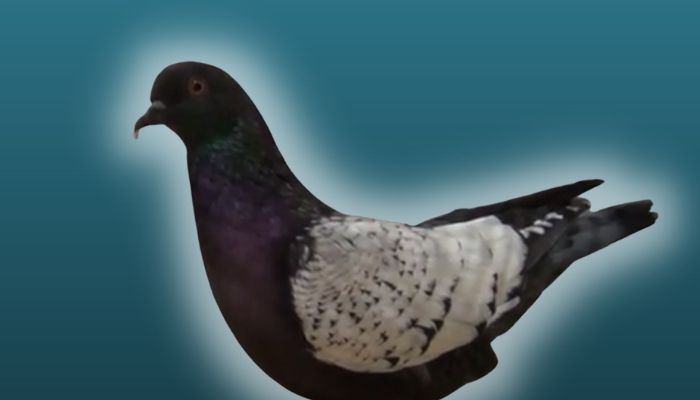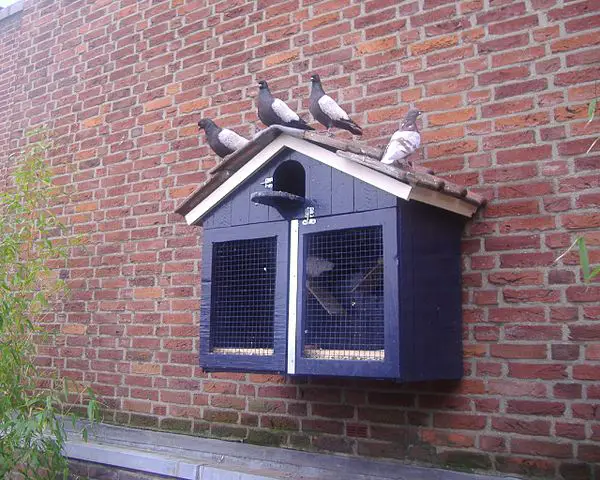The Hyacinth pigeon is defined by it’s colors and characteristics.
This breed of pigeon is rare throughout the world and its population is slowly decreasing despite its lifespan of up to 5 years.
It is most commonly seen in France and is a highly popular breed among their bird watching community.

It can be difficult to find a high quality Hyacinth pigeon.
You may have a nice looking bird, but if its spangling is too coarse or too light blue, then it will not fare well in competitions.
Hyacinth Pigeon Origins
Sources suggest that the Hyacinth pigeon originates from France as the populations of them are higher in Europe.
Some written texts conclude that the Hyacinth pigeon has much in common with the Suabian suggesting that they are related.
Buffon (1774), Boitard and Corbie (1824) described a fair number of speckled breeds, some of which may have been Hyacinth pigeons.
In 1887, Lyell classified the Hyacinth pigeon as a French breed, calling it the Pigeon maille Jacinthe, aka the speckled Hyacinth pigeon.
The Hyacinth appears to have much in common with the Suabian and they are probably related.
Hyacinth Pigeon Appearance
The Hyacinth pigeon is plain-headed and plain-legged with no ornamentation, however the extreme colors and patterns it has makes up for this.
The Hyacinth pigeon is quite small, but they display a range of colors from dark green to slight yellow to the iconic grey.
Getting the color correct is very difficult and is one of the reasons why this bird is so tricky to breed.

It has a sturdy urban pigeon shape that has a smooth and tight feathering. Its tail should be carried as an extension of its back, which sits at an angle of around 30°.
The bird’s under-color is slate blue, and it has a dark tail bar.
A Hyacinth pigeon’s neck, head and chest are a dark blue-grey color. On the belly, the color becomes slightly lighter.
The bird’s shield feathering is white spangled markings that are usually distributed over almost the entire shield.
Large flight feathers and so-called ‘finch-marking’ or “pearl markings” or “round dots” should be present.
Very High Fliers
These are one of many varieties of pigeons that can see UV light and cannot understand mirrors.
The Hyacinth pigeon can fly as high as 7000 feet high compared to the 6000 feet for other breeds.
The reasoning behind this is that due to its slightly larger body-wing length ratio, it can achieve greater thrust, with its beak forced down allowing for fast speeds up to and over 80 mph.
Breeding The Hyacinth Pigeon
To be successful in breeding the Hyacinth pigeon you must follow simple requirements.
There should be no slacking during breeding these pigeons as they are susceptible to many diseases, parasites, etc. that must be managed quickly.
The following are recommended for successful breeding.
You need a protected shelter away from natural elements, a fly pen and/or access to the open world, and separation between mated and odd birds.
There should be suitable mineral rations clear of contamination, and a suitable feed that is also clear of contamination.
You need water that is suitable for human consumption, and suitable nesting materials, such as hay, long grass etc.
The sad part is that you are not going to get it right every time.
The bird’s physical attributes and colors are very difficult to reproduce.
Many times, you will have very good-looking birds, but their colors may be too light, feathers too coarse, or there may be something that keeps them from being show-worthy pigeons.
In most cases, you have to keep mixing up your breeding pairs with the hopes their juveniles will grow into correctly proportioned, correctly feathered, and correctly colored Hyacinth pigeons.
What’s more, if you are buying juveniles from dealers, remember that juveniles look very different to their adult parents, and it is only when they are nearer maturity that they actually look like Hyacinth pigeons.
When they are young, they look very different, which is also frustrating because it means you have to keep the pigeons a long time before you discover if they are show-quality Hyacinth pigeons, or if they are regular okay-looking pigeons.
Hyacinth Pigeon Character
People have classed the Hyacinth pigeon as an exotic show bird but naturally it is a wild bird.
The bird is hard to domesticate and therefore cannot be trained easily.
The Hyacinth pigeon is not suggested as a house pet as it requires a larger than usual fly pen.
They are not particularly aggressive or skittish and are quite comfortable sitting with you in the garden, but they do not have the same roguish or playful personality that other pigeons have.
Hyacinth pigeons are good for people who don’t are patient and willing to persevere with the breeding process.
Resources:
